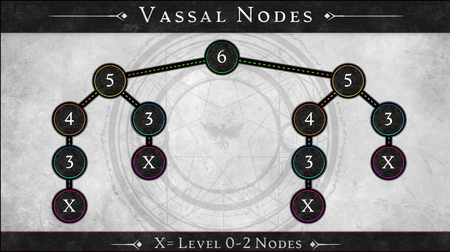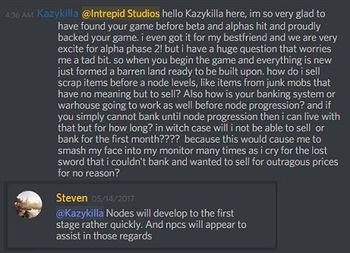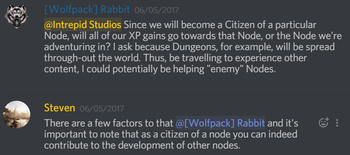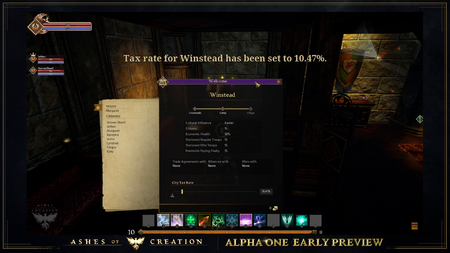Nodos vasallos

This vassal mode structure tells you what it looks like for a sovereign at a level six metropolis stage; and what it can control at a maximum vassal network is two level five nodes, of which a level five node can control one level four and one level three as direct vassals; and then the four can control a three; and every three can control a one or a two. Now if the three gets removed through siege, the one or the two is removed as well. So that's an important distinction between the three's vassals, which technically isn't really a vassal relationship because there's no citizenships possible. Those vassals don't exist between three and X, but they do exist between four and three, five and four, and six and five. And what this also allows is that because there are 85 nodes that are within the world, we have a buffer zone of about 20 nodes that lives in a max server state. So if you had maximum five metropolises form in a world, you will have a number about 20 nodes that can live alongside those metropolis networks; and when or if a metropolis falls, that extra cushion of nodes around the five metropolis structures allows for the map to be redistricted in a way that is unique. It doesn't mean that one of the fives is just going to pick up where the last six left off and form the same exact metropolis structure. From a territory perspective it has ancillary nodes to play with and expand towards that redistricts the map, so that if a metropolis falls there's a significant difference in the layout of the world and the layout of these almost nation-like territories.[1] – Steven Sharif
Los nodos de nivel aldeas (fase 3) o superior subyugan a los nodos cercanos, convirtiéndolos en nodos vasallos.[2][3]
- Una Metropolis (fase 6) puede tener bajo control hasta dos nodos Ciudad (fase 5). Un Ciudad (fase 5) puede controlar una Pueblo (fase 4) y un nodo Aldea (fase 3). Un Aldea (fase 3) puede controlar un Campamento (fase 2) o unaExpedición (fase 1). Si la Aldea (fase 3) es destruída a causa de un asedio, sus "vasallos" también son destruídos.[1]
- Los nodos vasallos obtienen beneficios de su nodo soberano (nodo padre) incluso si el tipo de nodo padre es diferente al vasallo.[5]
- It is not a bad thing to be vasseled, it is a good thing to be vasseled. It brings many benefits from the Sovereign, which is the ultimate parent of that vassal network down to the vassal node itself; and it allows that vassal node to even live outside of its normal mechanics. You get to adopt some of the benefits that the node type of your sovereign is, even if your node type as a vassal node isn't the same.[5] – Steven Sharif
- Los nodos soberanos recogen impuestos de los nodos vasallos. Estos impuestos no pueden ser cogidos por el alcalde u otros jugadores.[6]
- Los nodos vasallos deben permanecer, al menos, una fase de nodo por debajo de su nodo padre.[2]
- Los nodos vecinos/adyacentes a un nodo de Expedición (fase 1) bloquean el avance de sus vecinos adyacentes. Esto iba a ser probado durante la fase de test de Alpha-1.[7][3]
- Los nodos vasallos aplican primero cualquier experiencia obtenida para compensar su propio déficit (ver debilitamiento de los nodos). Una vez completa, aplican el exceso de experiencia ganada a su nodo padre.[8]
- Si el nodo padre avanza, el nodo vasallo puede avanzar también.[2]
- Los nodos vasallos dan su exceso de experiencia a su nodo padre, y pueden tener sus propios nodos vasallos; siempre y cuando estén dentro de la zona de influencia del nodo padre.[6][2]
- Si un nodo está bloqueado, y ademas de ser un nodo vasallo tiene sus propios nodos vasallos, cualquier experiencia ganada por el propio nodo o sus vasallos se aplica primero a su propio déficit. La experiencia sobrante a partir de ahí se manda al nodo padre.[8]
- When the vassal reaches its cap it overflows experience up to the parent; and so it can be very good early on for parents to get vassal nodes that are very productive- that have a lot of traffic.[6] – Steven Sharif
- Los nodos vasallos están supeditados al gobierno, alianzas, guerras, impuestos, y al comercio de su nodo padre, y pueden recibir ayuda "federal" del mismo.[2]
- Los nodos vasallos no pueden declarar la guerra a su nodo padre o a cualquiera de sus vasallos.[2]
- Los ciudadanos de los nodos vasallos están vinculados a las condiciones diplomáticas de su nodo padre.[2]
If a Node is a Vassal Node and is capped from advancing further, it first applies any experience earned to its own deficit (see Node Atrophy section), and then applies excess experience earned to its Parent Node. If the Parent Node advances and the Vassal is able to grow, it becomes uncapped. If a Node is capped and is both a Vassal and has its own Vassals, any experience earned from itself or its Vassals is first applied to their own deficit. Any experience beyond that is then sent to its Parent Node.[8] – Margaret Krohn
Avance del nodo
La actividad de los jugadores, ciudadanos y no ciudadanos, como (questear, recolectar, raids, etc.) dentro de la ZOI de un nodo contabiliza para el avance de ese nodo en particular (progresión) a una fase superior.[8][9]
El avance de un nodo desbloquea sus ventajas únicas, aunque puede bloquear el avance de los nodos vecinos hacia sus siguientes fases, al incrementar su anillo de influencia.[10]
- Los nodos avanzan hacia su primera fase muy rápido. Esto habilita algunos PNJs como vendedores o el almacenamiento de objetos.[11]
- Cuanto más avanza el nodo, más ámplia se vuelve su ZOI.[12]
- Los nodos menos evolucionados (conocidos como nodos vasallos) que entran dentro de la ZOI de otros nodos pueden seguir ganando experiencia, pero siempre permanecerán en una fase inferior a la del nodo dominante.[13]
- El sistema de vasallaje comienza cuando un nodo alcanza la fase de Aldea (fase 3), sin embargo, los nodos vecinos a partir de la fase Expedición (fase 1)también bloquean el avance de sus propios nodos vecinos.[7][3]
- El algoritmo de expansión de territorio tiene en cuenta la costa más cercana, los nodos vecinos y el "mapa de calor" de los jugadores en las zonas circundantes durante las últimas semanas y meses.[14]
- Debido la forma en la que el algoritmo calcula la expansión del territorio (ZOI) durante el avance del nodo, hay una pequeña posibilidad de que nodos nodos en la misma fase terminen estando el uno cerca del otro.[15]
- The way that the algorithm expands the territories takes into account a few things: One it takes into account the coast like where's the closest coast. Two it takes into account the neighboring nodes so it can take over and essentially vassal state those nodes, but what's more important is essentially the initial population based on like how players choose their races. Because we have nine different races and four different starting points that branch out, each server's population density is going to dictate essentially the first few nodes that are highly populated and then that initial seed is what's going to determine the node structure as it moves inland into the into the world essentially; and based on the performance and successes of different sieges will determine which nodes that got locked out from the previous the initial advancements what nodes can now be available to advance further. So I really think that with so many variables that are present in the equation of how nodes advance and stay existing with the more variables you have, the higher likelihood there is for there to be a significant diversion in world progression.[14] – Steven Sharif
- Normally the algorithm that's applied to the node territorial expansion will prevent significant nodes from being in close proximity to each other... There could be a perfect storm where all of the algorithmic progression of territory leads to having these nodes very close to each other because there's certain requirements that should that need to be available to satisfy node vassal takeovers; and it's possible that two nodes would never take each other over as vassals and end up close together and spanning their territories in opposite directions: The Tale of Two Cities thing.[15] – Steven Sharif
- Un nodo no recibirá experiencia de los nodos dentro de su ZOI hasta que ese nodo no haya alcanzado su límite.[13]
- Los ciudadanos de un nodo pueden contribuir al avance de otros.[16]
- El porcentaje de experiencia que ganan los nodos será equitativa entre los cuatro tipos de nodo.[17]
- Different people have different resources invested in nodes progressing and it would be a little "gamey" if you could know exactly what was necessary at that point because that would disincentivize people from participating.[18] – Steven Sharif
La mejora del nodo mostrará una serie de animaciones y efectos visuales (dentro del área del nodo).[19][8]
- Los jugadores serán desplazados a zonas seguras si se cruzan con nuevos objetos generados durante el avance del nodo.[19][20]
- Los recursos aparecerán al rededor del nodo y el sistema mostrará una serie de caravanas llegando al nodo con esos recursos. Estas caravanas no podrán ser atacadas.[19]
- Algunos PNJs comenzarán con actividades de construcción.[19]
- Los jugadores fuera del nodo podrán ver como el aspecto del nodo va cambiando a medida que avanza hacia su nuevo nivel.[19]
- The Development Area of a Node is where civilization will appear as the Node advances. As the Node Stage increases, different buildings, NPCs, and services will become available in the Development Area. The higher the Node Stage, the more complex and populated the Development Area becomes. Development Areas will also vary depending on the Node Type - Economic, Military, Scientific, or Divine.[8] – Margaret Krohn
Taxation
Los alcaldes pueden establecer los impuestos en sus nodos.[21]
- Esto incluye los impuestos para los juegos de taberna.[22][23]
Los alcaldes/gobernantes de los nodos asignan recursos, impuestos, and misiones para ayudar a desarrollar las defensas de los nodos.[24]
- El dinero de los impuestos solo se puede destinar al desarrollo de los nodos. Este oro no puede ser retirado por el alcalde ni por ningún otro jugador.[6][25]
- Las tasas de los impuestos varían según el momento en el que el jugador se unió al nodo como ciudadano. el objetivo de esto, es aplicar cierta presión financiera sobre las poblaciones de los nodos, haciendo que los impuestos sean cada vez más altos conforme el nodo avanza en lugar de establecer límites de población.[26]
Los nodos madre (soberanos) se llevan una parte de los impuestos de la vivienda así como de los servicios que se den en cualquier de sus nodos vasallos.[6][27]
- Estos impuestos no tienen porqué afectar a los ciudadanos, ya que los niveles de impuestos de los ciudadanos vienen impuestos directamente por su nodo,pero las finanzas del nodo si que se ven afectadas por los impuestos recaudados por los nodos madre (soberanos).[27]
Debilitamiento de los nodos
Los nodos acumulan cada día un déficit de experiencia basado en el niveld el nodo, llamado atrofia del nodo. The deficit is subtracted from any experience earned that day. Si queda algún déficit, se resta del reserva de experiencia del nodo.[8]
- Puede implementarse un sistema de atrofia, en el que los puntos de atrofia acumulados deshabilitarán progresivamente los servicios de un nodo. El nodo puede ser destruído si se alcanza un umbral de puntos significativo.[15]
- Un diseño anterior consistía en que los nodos podían bajar de nivel en función de la atrofia acumulada.[15][8]
- There are intrinsic problems with reducing a nodes level as opposed to removing the node and it may be possible I'm just gonna say now that we don't actually atrophy nodes to delevel but rather accrue atrophy points that must be replenished over time; and if not it begins to disable services and further compound the atrophy problem; at which point when it reaches a certain atrophy point then the node would just disappear.[15] – Steven Sharif
Ver además
Referencias
- ↑ 1.0 1.1 1.2 Transmisión en vivo, 2022-08-26 (1:07:34).
- ↑ 2.0 2.1 2.2 2.3 2.4 2.5 2.6 Blog - Know Your Nodes - The Basics.
- ↑ 3.0 3.1 3.2

- ↑

- ↑ 5.0 5.1 Transmisión en vivo, 2022-08-26 (1:04:35).
- ↑ 6.0 6.1 6.2 6.3 6.4 Transmisión en vivo, 2022-08-26 (1:10:16).
- ↑ 7.0 7.1

- ↑ 8.0 8.1 8.2 8.3 8.4 8.5 8.6 8.7 Blog - Know Your Nodes - Advance and Destroy.
- ↑ A reactive world - Nodes.
- ↑ Vídeo, 2017-04-20 (0:02).
- ↑

- ↑ Node series part II – the Metropolis.
- ↑ 13.0 13.1 Transmisión en vivo, 2017-10-16 (50:20).
- ↑ 14.0 14.1 Entrevista, 2020-07-18 (10:04).
- ↑ 15.0 15.1 15.2 15.3 15.4 Entrevista, 2020-07-08 (1:00:15).
- ↑

- ↑ Transmisión en vivo, 2021-09-24 (1:21:23).
- ↑ 18.0 18.1 Transmisión en vivo, 2017-05-26 (28:16).
- ↑ 19.0 19.1 19.2 19.3 19.4 Transmisión en vivo, 2022-10-14 (55:13).
- ↑ Transmisión en vivo, 2017-11-17 (55:27).
- ↑ 21.0 21.1 Transmisión en vivo, 2020-03-28 (1:03:38).
- ↑

- ↑

- ↑

- ↑

- ↑ Entrevista, 2020-03-27 (0:30).
- ↑ 27.0 27.1 Entrevista, 2018-05-11 (57:02).
